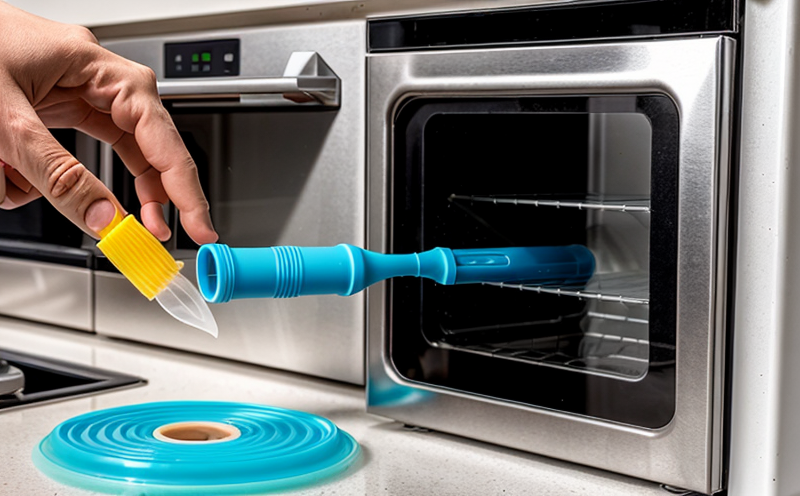ISO 868 Shore Hardness Testing of Household Plastics
The ISO 868 Shore hardness test is a fundamental method used to evaluate the resilience and durability of household plastics. This testing procedure measures the resistance of a material to indentation, which provides insights into the material's rigidity and quality. In the context of household plastics, this information is crucial for manufacturers and suppliers who aim to ensure the longevity and safety of their products.
Household plastics are a diverse group that includes items such as kitchen utensils, toys, electronics casings, and furniture components. The Shore hardness test helps in understanding how these materials will perform under various conditions, including impact, abrasion, and temperature fluctuations. This is particularly important for ensuring the safety of consumers, especially when dealing with items intended for young children or those that come into regular contact with food.
The testing process involves using a Shore hardness tester, which applies a standard force to the surface of the plastic specimen and measures the indentation made. The result is expressed as a Shore hardness value on the appropriate scale (usually A or D). This value indicates the relative hardness of the material compared to other plastics.
For household plastics, the Shore hardness test can be crucial in several ways:
- Material Selection: It aids in choosing the most suitable materials for specific applications, ensuring that the product meets both functional and safety requirements.
- Quality Control: By regularly testing samples throughout production, manufacturers can ensure consistency and reliability of their products.
- Safety Compliance: Meeting regulatory standards such as those set by international bodies like ISO ensures that the products are safe for consumer use.
The test is particularly important in sectors where aesthetic appeal, comfort, and safety are paramount. For instance, in kitchenware manufacturing, understanding the Shore hardness of plastics helps in designing handles that provide a comfortable grip without compromising on strength or durability.
When preparing specimens for testing, it's crucial to ensure they meet specific criteria set by ISO standards. This includes ensuring uniform thickness and absence of defects like cracks or warping. The specimen should also be conditioned appropriately before testing to reflect real-world conditions accurately.
Why It Matters
The Shore hardness test is not just a procedural requirement but a critical component in ensuring the quality and safety of household plastics. For manufacturers, this test provides essential data that can influence product design and development. By understanding how different materials will perform under various conditions, they can make informed decisions about material selection, which ultimately leads to better products.
From a consumer perspective, the results of Shore hardness testing translate into safer, more durable products. Consumers expect household items to be robust enough to withstand daily use without breaking or degrading over time. The test ensures that these expectations are met, thereby enhancing customer satisfaction and trust in the brand.
The test also plays a vital role in compliance with various regulations and standards. Many countries have specific requirements for the materials used in household products, particularly those intended for children. Meeting these standards not only avoids legal issues but also enhances the reputation of the company as a responsible and trustworthy manufacturer.
Applied Standards
The Shore hardness test is governed by ISO 868, which provides detailed guidelines on how to conduct this testing accurately. The standard specifies the types of specimens that can be tested, the instruments required, and the procedures to follow during the test.
- ISO 868-1:2015 – This part of the ISO standard covers Shore hardness testing using a durometer with a D-shaped indenter. It specifies the procedure for determining the hardness of rigid plastics and elastomers.
- ISO 868-2:2013 – This part addresses Shore hardness testing using a durometer with an A-shaped indenter, which is suitable for softer materials like rubber.
In the context of household plastics, the D scale (from ISO 868-1) is most commonly used. It ranges from 0 to 100 and provides a clear indication of the hardness of rigid plastics such as those found in kitchen utensils or furniture components.
The application of these standards ensures that tests are conducted consistently across different laboratories, providing reliable and comparable data. This consistency is crucial for manufacturers who need to ensure their products meet international quality benchmarks.
Environmental and Sustainability Contributions
The Shore hardness test plays a role in promoting sustainability by ensuring that household plastics are durable and long-lasting, reducing the frequency of product replacements. This extends the lifecycle of products, thereby decreasing waste generation.
- Eco-friendly Materials: By selecting materials with appropriate Shore hardness values, manufacturers can choose more sustainable options that are less likely to degrade quickly under environmental conditions.
- Energy Efficiency: Durable products mean fewer replacements and less energy used in manufacturing new items. This contributes to lower overall carbon footprints.
- Recycling Potential: Understanding the hardness of plastics can also influence their recyclability, as harder plastics may be more easily recycled into new products without losing quality.
The Shore hardness test is thus a vital tool in the broader sustainability efforts, helping to create products that are not only functional but also environmentally responsible.





